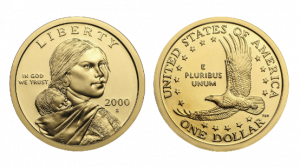The Native American Woman Behind Lewis & Clark’s Legendary Expedition Westward
Posted on“We were now about to penetrate a country at least two thousand miles in width, on which the foot of civilized man had never trod. The good or evil it had in store for us was for experiment yet to determine…I could but esteem this moment of my departure as among the most happy of my life.” –Meriwether Lewis, from The Journals of Lewis and Clark.
The historic 1803 Louisiana Purchase from France became one of President Thomas Jefferson’s most notable and lasting achievements. The Louisiana Purchase expanded the United States by about 828,000 square miles of territory – doubling the size of our young nation.
After the purchase, the door opened for quick expansion westward for adventuresome Americans. President Jefferson quickly commissioned the legendary Lewis and Clark expedition to explore the lands acquired in the Louisiana Purchase. Jefferson tasked the intrepid explorers to survey the terrain, create maps, learn about the Native Americans who lived on that land, and collect scientific specimens of plants and animals.
Jefferson’s secretary, Meriwether Lewis, led this remarkable adventure through the wilds westward. Lewis, 29, asked his friend and former military superior, 33-year-old William Clark, to be his co-captain on the expedition westward from the Mississippi River to the Pacific Coast.
Sacagawea’s Valuable Language Skills
The team was fortunate to have Sacagawea, a Native American Shoshone woman, as their interpreter and guide on their journey from 1804-1806. Sacagawea contributed greatly to the expedition’s success.
Sacagawea’s language skills as a translator were invaluable as they encountered Native Americans who might otherwise have gone into attack mode against the strangers in their land. It is said that Sacagawea and her infant served as a “white flag” of peace for the expedition westward, as war parties did not include women and infants. Not a single member of the Lewis & Clark party was lost to hostile action.
Sacagawea was bilingual in two very different Native American tribal languages – Hidatsa and Shoshone. Her husband spoke French, English, and Hidatsa. This translation chain was viewed as extremely valuable. Lewis and Clark needed all the help they could get communicating with the Shoshone tribes at the headwaters of the Missouri River.
Astoundingly, Sacagawea accompanied the legendary group on this difficult and long journey all while caring for the son she bore just two months before departing.
The Golden Coin that Honored the Legendary Native American Woman
In 2000, The United States Mint bestowed a great honor on Sacagawea’s memory and her significant contributions to the early explorations of our great nation with the production of the Sacagawea Golden U.S. Dollar coin. The coin was minted under the auspices of the United States $1 Coin Act of 1997.
Sculptor Glenna Goodacre’s design won a national design contest for her representation of Sacagawea with her infant son, with the reverse side of the coin featuring an eagle representing peace and freedom.
By and large, the majority of gold Sacagawea coins are not rare and circulated coins do not carry numismatic value. They are also not true gold coins, despite the golden color. The coins were composed of primary copper (77%), with small portions of zinc, manganese, and nickel.
The coins still circulate today, but proved to be ultimately proved to be unpopular with the public and are not widely used.
Golden Proof Coins in Space
Interestingly, 39 Proof 2000-W Sacagawea Dollar coins were struck in 22 Karat gold at the West Point Mint in June 1999. While 27 were ultimately melted, the remaining dozen examples took a journey into space on board the space shuttle Columbia. The coins returned to earth five days later on July 22, 1999. The dozen gold Sacagawea proofs were then sent to the Gold Bullion Depository in Fort Knox, Kentucky.
Some Circulating Sacagawea’s Are Valuable
There are a few key dates that are rare and have value beyond the $1 mark on the coin. The U.S. Mint embarked upon partnerships with both Wal-Mart and General Mills to promote the use of the Sacagawea coin in commercial transactions. The partnership with General Mills included 10,000,000 boxes of Cheerios cereal that would contain a Lincoln cent as a prize or a new Sacagawea dollar. Some lucky Cheerios breakfasters would receive a certificate redeemable for 100 Sacagawea dollars.
Some of the gold Sacagawea coins that were found in the Cheerios boxes were struck from a different set of dies. Within numismatic circles, these coins which showed “high detail” and enhanced eagle feathers on the reverse side of the coin became known as the “Cheerio Dollars” or “enhanced reverse die.” These are valuable and depending on the grade have sold for $5,000 to $25,000.
Want to read more? Subscribe to the Blanchard Newsletter and get our tales from the vault, our favorite stories from around the world and the latest tangible assets news delivered to your inbox weekly.









